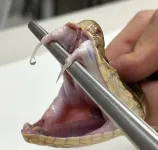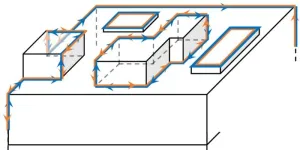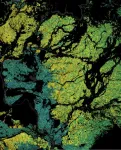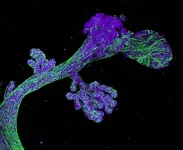(Press-News.org) What makes a soldier switch sides? That is a really good question. Especially when the soldier is an antibody that is supposed to defend the body against one of the world's most dangerous snake venoms but instead ends up helping the venom kill the body.
The question has become topical after a group of DTU researchers slightly changed how they tested an antibody that had previously proven promising as an antidote to snake venom. In the first experiment on mice, the damaging effect on muscle tissue from the venom of Bothrops Asper, a Costa Rican lancehead snake, was neutralized as expected. But in the second experiment, the antibody enhanced the snake venom's potency, so that it no longer just affected the muscle tissue, but ended up killing the mice.
When and how the antibody was administered made the difference between life and death. In the first experiment, snake venom and antibody were mixed together for 30 minutes before being injected into the muscle tissue of the mouse. This method is only slightly similar to treating a real snakebite. In the second experiment, the researchers simulated the usual real-world scenario, where antivenom is administered after a snakebite: First, they injected the poison into the muscle tissue of the mouse. Three minutes later, they injected the antibody into the mouse's veins.
"The fact that the antibody amplifies the toxin when venom and antidote are administered in different ways is an incredibly interesting discovery from a research point of view," says Postdoc Christoffer Vinther Sørensen from DTU, who was the one testing the antibody when the observation was made.
"This is a significant discovery we have arrived at," says Professor Bruno Lomonte from the University of Costa Rica. Alongside his colleague, Professor Julián Fernández, he has collaborated with Christoffer Vinther Sørensen and his project supervisor at DTU, Professor Andreas Hougaard Laustsen-Kiel, for the past 4 years. They hope that the discovery will contribute to expediting the development of the next generation of antivenom, ensuring that many people in need can benefit from it sooner.
The discovery has just been published in the renowned scientific journal Nature Communications in the paper Antibody-dependent enhancement of toxicity of myotoxin II from Bothrops asper | Nature Communications.
The first time ADET is observed in connection with animal venoms.
The phenomenon, which the researchers have observed, is known as antibody-dependent enhancement of toxicity (ADET) and has not previously been observed in connection with toxins from the animal world and it remains a mystery in most areas. For example, scientists do not know how an antibody designed to combat venom can switch sides and instead intensify the toxins' attacks on the body.
"We haven't figured out how this happens, but it helps to identify another important aspect that should be tested when working with antibodies," says Christoffer Vinther Sørensen.
His research project is part of international research work aimed at finding a broad-spectrum antivenom based on human antibodies that can be used as treatment against the world's most dangerous snake venoms.
"Antibodies can fail in many ways. By mapping these ways, we and other antidote researchers in the future can ensure that promising antibodies are tested as soon as possible in the most essential experiments. We hope that this allows us to discard antibodies that are not optimal and quickly arrive at a final antivenom that can neutralize the world's most dangerous snake venoms," says Christoffer Vinther Sørensen and adds:
"While we don't know why a 'soldier' switches sides, we now know that it's something to keep an eye on, even with our close friends, the antibodies."
FACTS
ADET
- A complicated phenomenon
ADET, antibody-dependent enhancement of toxicity, is an immunological phenomenon similar to the phenomenon of antibody-dependent enhancement, ADE, which is already the subject of intense research.
ADE is best known from viral infections, where it can occur when antibodies from a previous infection with a particular virus bind to a new strain of the same virus or to a related virus, but do not neutralize it. This non-neutralising binding may then, in some cases, enhance the harmful effect of the virus, for example by making it easier for the virus to penetrate the body's cells.
Antibodies play a crucial role in the body's defense against pathogens. They are produced in the immune system and bind to bacteria, viruses, or toxins, preventing them from developing, penetrating the nerve pathways, or exerting their toxic effects.
NEW GENERATION OF ANTIDOTES
More than 100,000 people die annually from snakebites
In 2017, the World Health Organization (WHO) added snakebites to the list of neglected tropical diseases. Every year, 5.4 million people are bitten by snakes. Most happen in poor areas of the world where there is no viable market for pharmaceutical companies. Approximately 100,000 die from snakebites yearly, while three times as many are permanently disabled.
An international group of researchers, led by Professor Andreas Hougaard Laustsen-Kiel from DTU, is working to develop a new generation of broad-spectrum antivenoms that are effective against many snake species. The group aims to base antidotes on antibodies compatible with the human immune system and can eventually be cultivated in cell tanks.
END
Tests can reveal whether an antibody can turn into a killer
A promising antibody failed testing. This is good news for developing a broad-spectrum antidote against the world’s most dangerous snake venoms.
2024-01-16
ELSE PRESS RELEASES FROM THIS DATE:
The surface knows what lies beneath: physicists show how to detect higher-order topological insulators
2024-01-16
Just like a book can’t be judged by its cover, a material can’t always be judged by its surface. But, for an elusive conjectured class of materials, physicists have now shown that the surface previously thought to be “featureless” holds an unmistakable signature that could lead to the first definitive observation.
Higher-order topological insulators, or HOTIs, have attracted attention for their ability to conduct electricity along one-dimensional lines on their surfaces, but this property is quite difficult to experimentally distinguish from other ...
Dr. Marcus D. Goncalves inducted into the American Society for Clinical Investigation
2024-01-16
Dr. Marcus D. Goncalves Inducted into the American Society for Clinical Investigation
Dr. Marcus D. Goncalves, the Ralph L. Nachman, M.D. Research Scholar and an assistant professor of medicine in the Division of Endocrinology, Diabetes and Metabolism at Weill Cornell Medicine, has been elected as a member of the American Society for Clinical Investigation (ASCI) for 2024.
The ASCI is one of the nation’s oldest nonprofit medical honor societies and focuses on the unique role of physician-scientists in research, clinical care and medical education. It is comprised of more than 3,000 physician-scientists representing ...
Method improves detection of potential therapeutic tumor targets in human biopsies
2024-01-16
Many cancers, including some types of breast cancer, are driven by alterations in the activity of cellular enzymes called kinases. Therapies that directly inhibit these cancer-promoting activities have proven to be effective for patients in which individual driving kinases can be diagnosed.
One major challenge to this therapeutic approach is to accurately quantify tumor kinases in human biopsy samples. Many kinases are not abundantly present and are therefore more difficult to measure accurately. Although currently there are methods to quantify small amounts of kinases, measuring multiple kinases ...
Canadian Science Publishing goes live on OA switchboard
2024-01-16
As part of our open science strategy, Canadian Science Publishing (CSP) is pleased to announce our new partnership with OA Switchboard, a mission-driven, community led initiative designed to simplify the sharing of information between stakeholders about open access publications throughout the whole publication journey.
“We’re thrilled to partner with the OA Switchboard to improve the visibility of the work we publish,” says Elaine Stott, Chief Executive Officer of CSP. “This initiative enables institutions, consortia and funders to report ...
A new, rigorous assessment of OpenET accuracy for supporting satellite-based water management
2024-01-16
Sustainable water management is an increasing concern in arid regions around the world, and scientists and regulators are turning to remote sensing tools like OpenET to help track and manage water resources. OpenET uses publicly available data produced by NASA and USGS Landsat and other satellite systems to calculate evapotranspiration (ET), or the amount of water lost to the atmosphere through soil evaporation and plant transpiration, at the level of individual fields. This tool has the potential to revolutionize water management, allowing for field-scale ...
Multisite clinical trial will compare three FDA-approved drugs for Rett syndrome treatment
2024-01-16
Vanderbilt University Medical Center received a $13 million Department of Defense grant to lead a multisite clinical trial that will evaluate repurposed FDA-approved drugs as treatment options for patients with Rett syndrome.
Affecting 1 in 10,000 females at birth, and males even more rarely, Rett syndrome is a rare genetic neurodevelopmental disorder that affects brain development.
“It robs affected individuals of the ability to use their hands or speak and causes problems with mobility, as well as a number of other issues,” said Jeffrey Neul, Annette Schaffer Eskind Professor, ...
St. Jude Home Care, LLC is first US pediatric home health agency to earn new category of industry certification
2024-01-16
St. Jude Children’s Research Hospital announces today that St. Jude Home Care LLC, a home health agency for the hospital’s patients, earned dual certifications in both pediatrics and home health from Community Health Accreditation Partners (CHAP), an independent, non-profit, accrediting body for home and community-based healthcare organizations. St. Jude Home Care LLC is the nation’s first agency to achieve that distinction. CHAP is the only organization in the U.S. that grants a discrete pediatric certification ...
Study pinpoints breast cancer ‘cells-of-origin’ in high-risk women
2024-01-16
Australian scientists have pinpointed likely ‘cells-of-origin’, the source cells that can grow into breast cancer, in women carrying a faulty BRCA2 gene who are at high risk of developing the disease.
The WEHI-led study also showed these cells have potential to be targeted with an existing cancer drug to delay tumour growth, in findings that may lead to future preventive treatments for the disease.
At a glance
Women with faulty BRCA2 genes are at a substantially higher risk of developing breast ...
Supports help keep Aussie firefighters safe
2024-01-16
House fires, road crashes and emergency rescues – they’re all part of the job for Aussie firefighters. And in such physically demanding roles, maintaining a high level of fitness and movement quality is essential.
Now, new research from health and fitness experts at the University of South Australia shows that professional firefighters have reduced movement quality as they age, which could put them at greater risk of injury.
Conducted by UniSA masters researcher, Alex Redshaw, in partnership with the South Australian Metropolitan Fire Service (MFS), the findings indicate that firefighters over the age of 50 generally have lower movement ...
Study: New deepfake detector designed to be less biased
2024-01-16
BUFFALO, N.Y. — The image spoke for itself.
University at Buffalo computer scientist and deepfake expert Siwei Lyu created a photo collage out of the hundreds of faces that his detection algorithms had incorrectly classified as fake — and the new composition clearly had a predominantly darker skin tone.
“A detection algorithm’s accuracy should be statistically independent from factors like race,” Lyu says, “but obviously many existing algorithms, including our own, inherit a bias.”
Lyu, PhD, co-director of the UB Center for Information Integrity, and his team have now developed what they believe are the ...
LAST 30 PRESS RELEASES:
Sleeping in on weekends may help boost teens’ mental health
Study: Teens use cellphones for an hour a day at school
After more than two years of war, Palestinian children are hungry, denied education and “like the living dead”
The untold story of life with Prader-Willi syndrome - according to the siblings who live it
How the parasite that ‘gave up sex’ found more hosts – and why its victory won’t last
When is it time to jump? The boiling frog problem of AI use in physics education
Twitter data reveals partisan divide in understanding why pollen season's getting worse
AI is quick but risky for updating old software
Revolutionizing biosecurity: new multi-omics framework to transform invasive species management
From ancient herb to modern medicine: new review unveils the multi-targeted healing potential of Borago officinalis
Building a global scientific community: Biological Diversity Journal announces dual recruitment of Editorial Board and Youth Editorial Board members
Microbes that break down antibiotics help protect ecosystems under drug pollution
Smart biochar that remembers pollutants offers a new way to clean water and recycle biomass
Rice genes matter more than domestication in shaping plant microbiomes
Ticking time bomb: Some farmers report as many as 70 tick encounters over a 6-month period
Turning garden and crop waste into plastics
Scientists discover ‘platypus galaxies’ in the early universe
Seeing thyroid cancer in a new light: when AI meets label-free imaging in the operating room
Neutrophil-to-lymphocyte ratio may aid risk stratification in depressive disorder
2026 Seismological Society of America Annual Meeting
AI-powered ECG analysis offers promising path for early detection of chronic obstructive pulmonary disease, says Mount Sinai researchers
GIMM uncovers flaws in lab-grown heart cells and paves the way for improved treatments
Cracking the evolutionary code of sleep
Medications could help the aging brain cope with surgery, memory impairment
Back pain linked to worse sleep years later in men over 65, according to study
CDC urges ‘shared decision-making’ on some childhood vaccines; many unclear about what that means
New research finds that an ‘equal treatment’ approach to economic opportunity advertising can backfire
Researchers create shape-shifting, self-navigating microparticles
Science army mobilizes to map US soil microbiome
Researchers develop new tools to turn grain crops into biosensors
[Press-News.org] Tests can reveal whether an antibody can turn into a killerA promising antibody failed testing. This is good news for developing a broad-spectrum antidote against the world’s most dangerous snake venoms.




